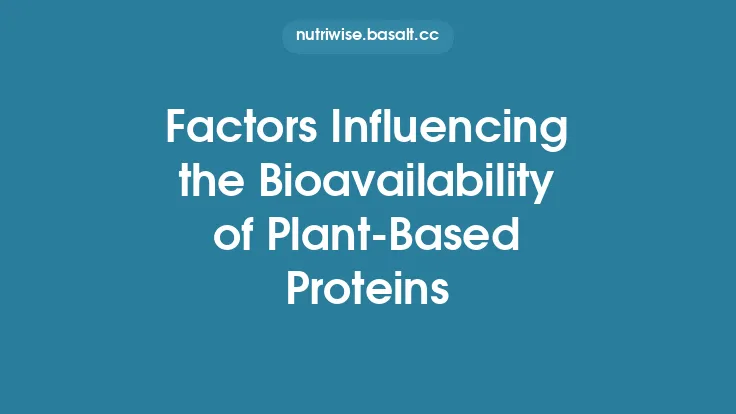Plant proteins have become a cornerstone of sustainable and ethical eating, yet their nutritional value hinges on more than just total protein content. The specific mix of amino acids they contain determines how well they can support muscle maintenance, enzyme function, hormone synthesis, and overall health. Understanding the amino‑acid profiles of the most common plant protein sources equips consumers, dietitians, and food developers with the insight needed to make informed choices, formulate balanced products, and address potential nutritional gaps.
Essential Amino Acids and Their Role in Human Nutrition
Humans require nine essential amino acids (EAAs) that must be obtained from the diet because the body cannot synthesize them in sufficient quantities:
| Amino Acid | Primary Physiological Functions |
|---|---|
| Histidine | Precursor to histamine; supports immune response and gastric acid secretion |
| Isoleucine | Branched‑chain amino acid (BCAA) involved in muscle repair and glucose regulation |
| Leucine | Potent stimulator of mTOR pathway, driving protein synthesis and muscle growth |
| Lysine | Critical for collagen formation, calcium absorption, and production of carnitine |
| Methionine | Sulfur donor for methylation reactions; precursor to cysteine and taurine |
| Phenylalanine | Precursor to tyrosine, dopamine, norepinephrine, and epinephrine |
| Threonine | Important for mucin production, immune function, and central nervous system health |
| Tryptophan | Precursor to serotonin and melatonin; influences mood and sleep |
| Valine | BCAA that supports energy production and muscle metabolism |
A complete protein supplies all nine EAAs in proportions that meet or exceed human requirements. Plant proteins often fall short in one or more EAAs, making the amino‑acid profile a critical metric for evaluating their nutritional adequacy.
Overview of Plant Protein Sources
Plant‑derived proteins can be grouped into several broad categories, each with distinct amino‑acid signatures:
- Legumes – beans, peas, lentils, chickpeas, and soy (though soy is treated separately in many guides).
- Cereals and Pseudocereals – wheat, rice, barley, oats, quinoa, amaranth, buckwheat, and millet.
- Nuts and Oil‑Bearing Seeds – almonds, walnuts, pistachios, pumpkin seeds, sunflower seeds, and sesame.
- Oil‑Free Seeds – chia, hemp, flax (often highlighted for omega‑3 content).
- Algae and Aquatic Plants – spirulina, chlorella, and duckweed.
- Root and Tuber Crops – potatoes, sweet potatoes, and cassava (lower protein density but notable for certain amino acids).
While total protein per 100 g varies widely (e.g., soy ~36 g, lentils ~9 g, quinoa ~4 g), the quality of that protein is dictated by the relative amounts of each amino acid.
Amino Acid Composition of Legumes
Legumes are celebrated for their high lysine content, a limiting amino acid in many cereals. A typical profile (per 100 g dry weight) looks like this:
| Amino Acid | Lentils | Chickpeas | Black Beans | Peas |
|---|---|---|---|---|
| Lysine | 2.5 g | 2.2 g | 2.3 g | 2.1 g |
| Methionine + Cysteine | 0.6 g | 0.5 g | 0.5 g | 0.4 g |
| Threonine | 1.2 g | 1.1 g | 1.1 g | 1.0 g |
| Tryptophan | 0.2 g | 0.2 g | 0.2 g | 0.2 g |
| Leucine | 2.0 g | 1.9 g | 1.9 g | 1.8 g |
| Isoleucine | 1.1 g | 1.0 g | 1.0 g | 0.9 g |
| Valine | 1.5 g | 1.4 g | 1.4 g | 1.3 g |
| Phenylalanine + Tyrosine | 2.2 g | 2.0 g | 2.0 g | 1.9 g |
| Histidine | 0.8 g | 0.7 g | 0.7 g | 0.6 g |
Key takeaways
- Lysine is abundant, making legumes an excellent complement to cereal proteins that are lysine‑deficient.
- Methionine and cysteine are the primary limiting amino acids in legumes, often requiring supplementation or combination with methionine‑rich foods.
- The BCAA content (leucine, isoleucine, valine) is moderate, supporting muscle maintenance when total intake is sufficient.
Amino Acid Composition of Cereals and Pseudocereals
Cereals typically excel in sulfur‑containing amino acids (methionine, cysteine) but are low in lysine. Representative data (per 100 g dry weight) are shown below:
| Amino Acid | Wheat (whole grain) | Brown Rice | Oats | Quinoa (pseudocereal) |
|---|---|---|---|---|
| Lysine | 0.5 g | 0.4 g | 0.5 g | 1.5 g |
| Methionine + Cysteine | 1.2 g | 1.0 g | 1.1 g | 1.0 g |
| Threonine | 0.9 g | 0.8 g | 0.9 g | 1.2 g |
| Tryptophan | 0.2 g | 0.2 g | 0.2 g | 0.3 g |
| Leucine | 1.5 g | 1.3 g | 1.4 g | 1.6 g |
| Isoleucine | 0.9 g | 0.8 g | 0.9 g | 1.0 g |
| Valine | 1.2 g | 1.0 g | 1.1 g | 1.3 g |
| Phenylalanine + Tyrosine | 2.0 g | 1.8 g | 1.9 g | 2.2 g |
| Histidine | 0.6 g | 0.5 g | 0.6 g | 0.7 g |
Key takeaways
- Methionine is relatively high, making cereals a valuable source of sulfur amino acids.
- Lysine is the limiting amino acid, often below the WHO/FAO reference pattern for adults.
- Quinoa stands out among pseudocereals for its more balanced profile, offering higher lysine than most true cereals.
Nuts, Seeds, and Oil‑Bearing Crops
Nuts and seeds provide a dense protein package alongside healthy fats. Their amino‑acid patterns are generally richer in arginine and glutamine, with variable EAA content:
| Amino Acid | Almonds | Pumpkin Seeds | Sunflower Seeds | Sesame Seeds |
|---|---|---|---|---|
| Lysine | 0.6 g | 1.0 g | 0.9 g | 1.0 g |
| Methionine + Cysteine | 0.5 g | 0.8 g | 0.7 g | 0.9 g |
| Threonine | 0.5 g | 0.9 g | 0.8 g | 0.9 g |
| Tryptophan | 0.1 g | 0.2 g | 0.2 g | 0.2 g |
| Leucine | 1.5 g | 2.0 g | 1.9 g | 2.0 g |
| Isoleucine | 0.9 g | 1.2 g | 1.1 g | 1.2 g |
| Valine | 1.2 g | 1.6 g | 1.5 g | 1.6 g |
| Phenylalanine + Tyrosine | 2.0 g | 2.5 g | 2.4 g | 2.6 g |
| Histidine | 0.5 g | 0.8 g | 0.7 g | 0.8 g |
Key takeaways
- Arginine (not listed in the table) often exceeds 2 g per 100 g, supporting nitric‑oxide production and vascular health.
- Lysine is moderate, but many nuts are limited in methionine relative to cereals.
- The high leucine content makes nuts and seeds useful for stimulating muscle protein synthesis when consumed in adequate amounts.
Algae and Emerging Plant‑Based Proteins
Microalgae such as spirulina and chlorella have attracted attention for their exceptionally high protein density (up to 65 % dry weight) and a near‑complete amino‑acid spectrum:
| Amino Acid | Spirulina (dry) | Chlorella (dry) |
|---|---|---|
| Lysine | 2.8 g | 2.5 g |
| Methionine + Cysteine | 1.2 g | 1.0 g |
| Threonine | 1.5 g | 1.4 g |
| Tryptophan | 0.4 g | 0.3 g |
| Leucine | 3.5 g | 3.2 g |
| Isoleucine | 2.0 g | 1.8 g |
| Valine | 2.5 g | 2.3 g |
| Phenylalanine + Tyrosine | 4.0 g | 3.8 g |
| Histidine | 1.0 g | 0.9 g |
Key takeaways
- Algal proteins often meet or exceed the WHO/FAO reference pattern for all EAAs, qualifying as complete proteins.
- The high methionine and cysteine levels complement legume‑based diets.
- Cultivation conditions (light intensity, nitrogen source) can shift the amino‑acid balance, offering a lever for targeted nutritional optimization.
Limiting Amino Acids and Protein Quality Metrics
Two principal indices are used to gauge protein quality:
- Protein Digestibility‑Corrected Amino Acid Score (PDCAAS) – compares the limiting EAA content to a reference pattern and adjusts for digestibility (scale 0–1).
- Digestible Indispensable Amino Acid Score (DIAAS) – newer, uses ileal digestibility of each EAA, providing a more precise picture for adults.
| Food | PDCAAS | DIAAS* | Limiting Amino Acid |
|---|---|---|---|
| Lentils | 0.71 | 0.68 | Methionine + Cysteine |
| Wheat (whole grain) | 0.45 | 0.44 | Lysine |
| Quinoa | 0.78 | 0.80 | None (near‑complete) |
| Pumpkin Seeds | 0.73 | 0.71 | Lysine |
| Spirulina | 0.92 | 0.95 | None (complete) |
\*DIAAS values are based on recent literature; values may vary with processing.
Interpretation
- A PDCAAS/DIAAS ≥ 0.8 is generally considered high‑quality.
- Foods with a low score are not “bad”; they simply require dietary complementarity or higher total intake to meet EAA needs.
- For athletes or individuals with elevated protein turnover, focusing on sources with high leucine and overall DIAAS is advantageous.
Factors Influencing Amino Acid Profiles
| Factor | Mechanism | Example Impact |
|---|---|---|
| Genotype / Cultivar | Genetic variation controls enzyme activity in amino‑acid biosynthesis. | High‑lysine bean varieties (e.g., “Lysine‑rich Phaseolus”) can raise lysine by 30 % compared with traditional cultivars. |
| Soil Nutrition | Availability of nitrogen, sulfur, and micronutrients (e.g., zinc) influences amino‑acid synthesis. | Sulfur‑deficient soils reduce methionine and cysteine in legumes. |
| Climate & Growing Season | Temperature and photoperiod affect protein turnover in plants. | Heat stress can increase free amino acids (e.g., proline) but may lower total protein content. |
| Harvest Timing | Maturity stage determines protein composition. | Early‑harvested peas have higher lysine; mature seeds accumulate more storage proteins rich in methionine. |
| Post‑Harvest Storage | Moisture and temperature can cause proteolysis or Maillard reactions. | Prolonged storage of wheat flour reduces lysine availability due to Maillard browning. |
| Processing (e.g., extrusion, fermentation) | Alters protein structure, digestibility, and sometimes amino‑acid composition. | Fermentation of soy reduces antinutrients, increasing lysine bioavailability; extrusion can degrade tryptophan. |
Understanding these variables helps producers select cultivars and agronomic practices that optimize amino‑acid quality for target markets.
Processing, Cooking, and Fermentation Effects
- Heat Treatment
- Denaturation improves digestibility by exposing peptide bonds.
- Excessive heat can cause Maillard reactions, especially with lysine, reducing its availability.
- Example: Boiling beans for 30 min improves protein digestibility by ~15 % but may reduce lysine by 5–10 % if cooking water is retained.
- Mechanical Processing
- Milling (e.g., producing flour) can concentrate protein in the bran fraction, altering the amino‑acid ratio.
- Extrusion (used for plant‑based meat analogues) can increase digestibility but may degrade heat‑sensitive amino acids like tryptophan.
- Fermentation
- Lactic‑acid bacteria and fungi produce proteases that break down storage proteins into peptides and free amino acids.
- Fermented products (e.g., tempeh, miso) often show higher lysine bioavailability and reduced antinutrients (phytate, tannins).
- Some strains can synthesize B‑vitamins alongside improving protein quality.
- Germination & Sprouting
- Activates endogenous enzymes, increasing free amino acids and reducing antinutrients.
- Sprouted lentils can exhibit a 20 % rise in lysine and a 15 % increase in overall digestibility.
- Enzymatic Treatment
- Commercial hydrolysis (e.g., for protein isolates) yields hydrolysates rich in branched‑chain amino acids, useful for sports nutrition.
- However, extensive hydrolysis may produce bitter peptides, requiring flavor masking.
Analytical Techniques for Determining Amino Acid Profiles
| Technique | Principle | Typical Sensitivity | Advantages | Limitations |
|---|---|---|---|---|
| Acid Hydrolysis + HPLC | Proteins are hydrolyzed with 6 M HCl; resulting amino acids are separated on a reverse‑phase column and detected by UV or fluorescence. | < 0.1 % w/w | Gold standard for total amino‑acid content; widely validated. | Destruction of tryptophan and sulfur amino acids; requires correction factors. |
| Pre‑column Derivatization (e.g., OPA, FMOC) + HPLC | Amino acids are derivatized to enhance fluorescence/UV detection. | 0.01 % w/w | Improves detection of low‑abundance amino acids; compatible with automated systems. | Additional sample preparation steps. |
| LC‑MS/MS (Multiple Reaction Monitoring) | Direct analysis of hydrolysates with mass spectrometric detection. | pg‑level | Simultaneous quantification of all 20 proteinogenic amino acids, including modified forms. | High instrument cost; requires skilled operators. |
| Amino Acid Analyzer (Ion‑Exchange Chromatography) | Classic method using post‑column ninhydrin detection. | 0.05 % w/w | Robust, reproducible; good for routine quality control. | Time‑consuming; limited to standard amino acids. |
| Near‑Infrared Spectroscopy (NIRS) | Predicts amino‑acid composition from spectral signatures calibrated against reference methods. | Dependent on calibration (R² > 0.9 typical) | Rapid, non‑destructive; suitable for large‑scale screening. | Requires extensive calibration set; less accurate for minor amino acids. |
For research and product development, a combined approach—using HPLC or LC‑MS/MS for definitive quantification and NIRS for high‑throughput screening—offers both precision and efficiency.
Implications for Diet Planning and Supplementation
- Meeting EAA Requirements
- Adults need roughly 0.66 g EAA kg⁻¹ body weight per day (FAO/WHO).
- A mixed plant‑based diet that includes at least one legume and one cereal per day typically satisfies this, provided total protein intake is ≥ 0.8 g kg⁻¹.
- Targeting Specific Populations
- Athletes & older adults benefit from higher leucine (≥ 2.5 g per meal) to trigger muscle protein synthesis.
- Pregnant or lactating women require extra lysine and tryptophan; incorporating soy, quinoa, or spirulina can help.
- Supplement Use
- When whole‑food intake cannot meet a particular EAA (e.g., methionine for vegans on a low‑cereal diet), targeted supplements such as methionine‑rich algae powders or pea‑protein isolates can bridge the gap.
- Branched‑chain amino acid (BCAA) supplements derived from plant isolates are available for performance‑oriented individuals.
- Balancing Antinutrients
- Phytates and tannins can impair mineral absorption and, to a lesser extent, protein digestibility. Soaking, sprouting, and fermentation mitigate these effects, indirectly improving amino‑acid utilization.
- Practical Meal Examples
- Breakfast: Quinoa porridge with pumpkin seeds and a splash of fortified plant milk (complete EAA profile).
- Lunch: Lentil‑based salad with mixed greens, sunflower seeds, and a drizzle of lemon‑olive‑oil dressing (high lysine, moderate methionine).
- Dinner: Stir‑fried buckwheat noodles with tofu and broccoli (balanced leucine and methionine).
These combinations illustrate how dietary diversity naturally resolves most limiting‑amino‑acid issues without the need for precise “protein combining” calculations at each meal.
Future Directions in Plant Protein Improvement
- Breeding for High‑Lysine Varieties
- Conventional and marker‑assisted selection have produced low‑tryptophan, high‑lysine beans and wheat lines. Ongoing programs aim to integrate these traits without compromising yield.
- Genome Editing (CRISPR‑Cas)
- Targeted knock‑out of feedback‑inhibition genes in the methionine biosynthetic pathway can raise methionine content in legumes. Early trials in peas show a 25 % increase.
- Synthetic Biology & Microbial Fermentation
- Engineered yeast and filamentous fungi can produce single‑cell proteins with tailored amino‑acid ratios, offering a scalable alternative to traditional crops.
- Precision Agronomy
- Sensor‑driven nitrogen management optimizes amino‑acid synthesis, reducing excess fertilizer use while enhancing protein quality.
- Functional Protein Design
- Combining protein isolates from complementary sources (e.g., pea + rice) at the formulation stage can achieve a complete amino‑acid profile with a DIAAS > 0.9, suitable for infant formulas and clinical nutrition.
These innovations promise to narrow the gap between plant and animal protein quality, reinforcing the role of plant proteins in a sustainable food system.
Practical Takeaways
- Assess the whole diet, not just individual foods. A varied plant‑based menu typically supplies all essential amino acids.
- Prioritize foods with complementary strengths: legumes for lysine, cereals for methionine, nuts/seeds for leucine and arginine.
- Mind processing: moderate heat improves digestibility, but avoid excessive cooking that destroys heat‑sensitive amino acids.
- Leverage traditional techniques—soaking, sprouting, fermentation—to boost amino‑acid availability and reduce antinutrients.
- Use analytical data (PDCAAS/DIAAS) when formulating products or planning high‑performance diets; aim for scores ≥ 0.8.
- Stay informed about emerging varieties and biotech advances that may offer higher‑quality plant proteins in the near future.
By appreciating the nuances of amino‑acid composition across common plant proteins, consumers can enjoy the ethical and environmental benefits of a plant‑centric diet while ensuring they meet their body’s fundamental nutritional needs.





